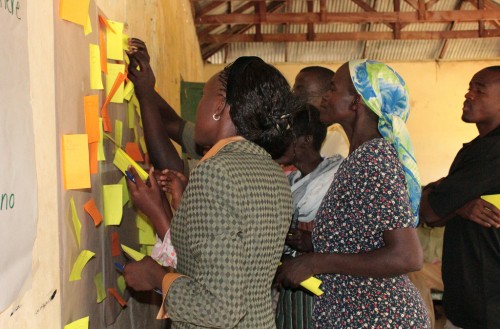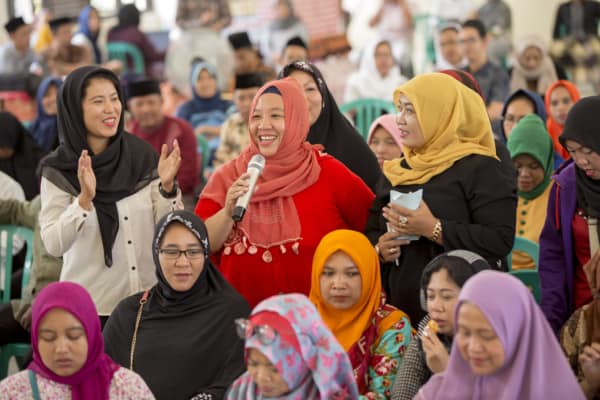It’s easy to forget that ‘gender‘ does not mean ‘women’ but actually means ‘gender relations’, or the relations between men and women. Gender analysis examines how power is distributed between women and men, how it operates, who can use it and for what purposes. It’s best understood as a system which shapes everything around us – what we think, what we know, whose knowledge is privileged, and which values are supported.
If this isn’t political, I don’t know what is.
So when I recently wrote a short report on gender in Political Economy Analysis (PEA), I thought it would be fairly easy – a chance to dig a bit deeper into PEA, probably some good resources out there. As a social development specialist, I often work on gender issues and find most development research is well on the way to embedding gender analysis. I was surprised, therefore, to find only a very simple inclusion of gender in PEA.
Helen Poulsen, the DFID adviser in the Democratic Republic of Congo who commissioned the report, has really put her finger on something here. It’s odd to find an analytical tool which explicitly discusses the power relations of individuals and institutions but doesn’t usually include a gendered analysis.
Where gender is evident in PEA, it’s mostly looking at how gender inequalities shape society and how many women are in positions of political and economic power. I found a few PEA studies for DFID that incorporate gender, and these focus on three broad themes:
- The role of gender in society: such as gender equality in formal and customary law, women’s property and business ownership.
- Women in positions of power and influence: for instance, how many women sit in parliament, how many are business or civil society leaders.
- The representation and influence of women’s groups: whether lobbying groups exist for women’s rights, and how much success they have.
A gender analysis would look at these issues but also delve deeper into how political economy affects men and women differently. It would be interesting to review, for example, whether women in positions of power exert real influence over policies. Or how gender dynamics block or facilitate change.
So, for instance, a political economy analysis of Malaysia’s economic success ought to consider that it’s underpinned by the institutionalisation of gendered and racial inequalities. Businesses regularly recruit female migrants with lower social capital and higher vulnerability, and pay them a lower wage than men (Griffin, 2007).
Where a PEA might ask ‘Does the political executive provide for regular, open, inclusive competition for political power?’, a gendered PEA would also ask ‘Are women and men equally able to access positions of political power?’. Questions about what voters expect their elected representatives to deliver should probably also ask whether men and women want different things from their representatives. Not to mention whether male and female representatives are expected to – or even able to – deliver the same results.
In the short desk-based study I did for DFID, some lessons emerged about how a gender analysis can inform PEAs. Certain sectors are defined in gendered terms – ‘women’s work’ or ‘men’s work’. Very practically, the interests of bureaucratic agencies can be gendered and have an impact on gender equality; if a ministry of women or social affairs is in charge of a programme, it is more likely to include gender equality goals than a ministry of finance or rural development (Jones and Holmes, 2011). And finally, gender analysis allows the inclusion of different and possibly competing voices.
There are, of course, counter-arguments. PEA does not refer to any specific demographic groups in its tools. So why should an analysis pay more attention to women than, say, ethnic minorities or young people? The argument goes that PEA isn’t social analysis, it is – the clue is in the name – political and economic. PEA tools are many, varied, and differently applied. I’ve reviewed only a small selection, so I expect that some do include gender when it appears relevant.
But the fact remains that PEA is very much about power analysis. This clearly echoes the thrust of feminist and gender studies and yet PEA doesn’t appear to draw on this established body of work. It’s not in doubt that the political economy of most countries is male-dominated, and that states and governments tend to be patriarchal. But it’s rare to find a political economy analyst who uses this as part of their analysis, unless they have an explicitly feminist perspective.
That PEA in general lacks a strong analysis of real politics and power is the central argument of a forthcoming DLP paper by Hudson and Leftwich (summary here, PDF 211 KB). This may partly explain why gendered power is missing from most PEA tools.
As they so succinctly put it (p.3): “Ultimately, if you wish to defeat poverty, prepare to address the power and the politics that keeps people poor. That’s why political analysis matters.”
And, I would add, also why gender matters to Political Economy Analysis.









